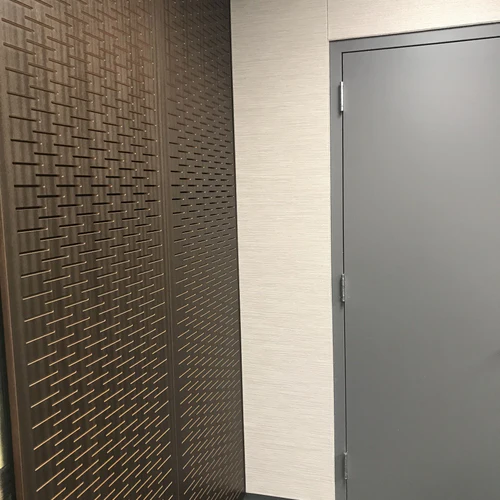When it comes to improving acoustics in a space, understanding the difference between soundproofing and sound absorption is essential. These terms are often used interchangeably, but they serve distinct functions. Acoustic panels play a significant role in both soundproofing and sound absorption, but their primary focus is absorption. In this article, we’ll explore the differences between soundproofing and sound absorption, how acoustic panels work, and why they are essential for creating optimal sound environments.
Soundproofing: What Is It?
Soundproofing refers to blocking or minimizing the transmission of sound from one area to another. The goal is to prevent sound from escaping or entering a room, creating a barrier between the interior and exterior. Soundproofing is commonly used in spaces where privacy or isolation is critical, such as recording studios, home theaters, and offices.
Key Soundproofing Methods
Soundproofing is typically achieved using materials and construction techniques that create physical barriers. These include:
- Mass-loaded vinyl: Heavy material used to block sound transmission.
- Double walls: Two walls with an air gap between them to reduce sound transfer.
- Insulated doors and windows: Specialized doors and windows designed to block external noise.
While acoustic panels can contribute to soundproofing, their primary function is different, as they focus more on sound absorption.
Sound Absorption: What Is It?
Sound absorption involves reducing echoes and controlling the way sound waves bounce around within a room. The primary goal of sound absorption is to improve sound quality inside a space, making it more comfortable and functional. Acoustic panels are specifically designed to absorb sound waves, preventing them from reflecting off walls, ceilings, and floors.
Acoustic Panels and Sound Absorption
Acoustic panels are made of materials that absorb sound energy. When sound waves hit an acoustic panel, they are trapped and dissipated, preventing echoes and reverberations. This creates a clearer and more pleasant sound environment.
Acoustic panels are commonly used in:
- Recording studios: To enhance sound clarity.
- Conference rooms: To prevent distracting echoes during meetings.
- Restaurants and open spaces: To reduce noise levels and create a calmer ambiance.
The materials used in acoustic panels, such as foam, fabric, and perforated wood, are engineered to absorb sound frequencies, particularly in the mid to high range. By strategically placing these panels around a room, you can significantly enhance the acoustic quality of the space.
Key Differences Between Soundproofing and Sound Absorption
Purpose
- Soundproofing: Focuses on blocking sound from entering or leaving a room.
- Sound absorption: Focuses on controlling sound within a room by reducing echoes and reverberations.
Materials
- Soundproofing: Uses heavy, dense materials to create barriers (e.g., concrete, mass-loaded vinyl).
- Sound absorption: Uses porous materials like acoustic foam, fabric, and fiberglass to absorb sound energy.
Functionality
- Soundproofing: Primarily used to isolate a room from outside noise or to contain noise within a room.
- Sound absorption: Used to improve sound quality within a room by controlling how sound waves behave.
Installation
- Soundproofing: Requires more extensive construction techniques, such as adding layers of drywall or installing soundproof windows and doors.
- Sound absorption: Can be easily achieved by installing acoustic panels on walls, ceilings, or floors.
How Acoustic Panels Contribute to Both
While the primary function of acoustic panels is sound absorption, they can contribute to soundproofing in some cases. Acoustic panels help reduce the overall noise levels within a room, which can indirectly lower the amount of sound that escapes to other areas. However, for true soundproofing, additional measures are typically required.
Choosing the Right Acoustic Panels
When selecting acoustic panels, it’s essential to choose the right material and design for your specific needs. For example, if you’re primarily focused on sound absorption for better audio quality, foam or fabric-covered acoustic panels are ideal. On the other hand, if you’re looking to complement soundproofing efforts, you may want to use thicker, denser panels or combine them with other soundproofing materials.
Read also this article: Increase Sales by Using Features of Custom Beard Oil Boxes
Conclusion
Understanding the difference between soundproofing and sound absorption is key to creating the optimal acoustic environment. Acoustic panels are highly effective for sound absorption, improving sound quality by reducing echoes and reverberations. While they play a lesser role in soundproofing, they can complement other soundproofing techniques to create a quieter, more comfortable space.
Whether you’re setting up a recording studio, home theater, or office, incorporating acoustic panels can dramatically improve the auditory experience. With proper placement and material selection, you can achieve the perfect balance of sound absorption and soundproofing to meet your needs.
By optimizing your acoustic setup with the right acoustic panels, you’ll enjoy better sound quality and a more peaceful environment.









